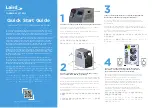
23
9 INCH CHIPPER
ENGLISH
SERVICE & MAINTENANCE
WARNING
BEFORE INSPECTING OR SERVICING ANY PART OF THIS MACHINE, SHUT OFF POWER SOURCE, DISENGAGE THE
HYDRAULICS, OPEN SHIELD AND MAKE SURE ALL MOVING PARTS HAVE COME TO A COMPLETE STOP.
5.5 REMOVING THE BLADES
Chipping blades are sharp! Use caution when working
on machine to avoid injury.
WARNING
5.6 SHARPENING THE BLADES
The blades can be ground on a bench grinder or by a
professional.
1. Never sharpen or grind the mounting surfaces of
the blades. This will cause the edge to roll and the
blade will be damaged, resulting in poor chipping
performance.
2. Regrind the angled edge of the chopping blades to
30 degrees (Figure 5.2). Use the blade angles on the
anvil spacing gauge when sharpening the blades to
achieve the proper angle (see Figure 5.3).
5.7 INSTALLING THE BLADES
1. Install the rotor lock (Section 5.2). The rotor is now
restrained for installing the blades.
2. Place a blade on the rotor and attach using original
hardware. Torque the bolts to 120 ft-lbs. (162 Nm).
Repeat for the remaining blade.
3. Lower the access cover and secure to the chipper
housing (see Section 5.3).
4. Remove rotor lock.
30
Figure 5.2, Chipper Blade Surfaces
1. Open access cover to allow access to rotor (see
Section 5.3). Rotate the rotor so that the bolts holding
the chipper blades are accessible.
2. Install the rotor lock (Section 5.2). The rotor is now
restrained for removing the blades. To access the
remaining blades, remove pin and reposition rotor.
Return pin to the rotor lock hole.
3. Remove the two bolts that hold the blade to the
rotor. The hardware can be reused. Repeat for the
remaining blade.
4. The blades have two edges and can be reversed one
time before sharpening.
3. Be careful when grinding so that the blade does
not become overheated and change color. This will
remove the heat-treated properties.
4. Use short grinding times and cool with water or some
type of liquid coolant.
5.
Remove an equal amount off each blade to maintain
rotor balance.
6. Small imperfections such as nicks and burrs on
the flat side of the blade will not affect the chipping
performance of the machine.
7. For blades that have been repeatedly sharpened,
ensure that the sharpened surface extends past
the chipping slot opening. If it does not extend past
the opening, the blades should be replaced (see
Section 5.4).
1/4”
1/2”
45 DEGREES
30 DEGREES
1/4”
1/2”
Figure 5.3, Anvil Spacing Gauge














































